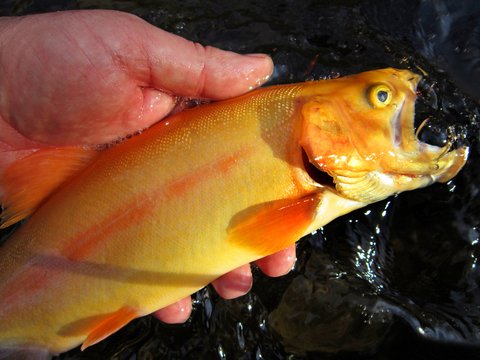High mountain lakes have a magical allure, especially to anglers. It’s where we go for the challenge of catching native trout, none of which is more prized than the illusive golden.
Although it is rumored to be the hardest trout to catch, you can up your odds by eliminating all the hoopla and sticking to some basic techniques on how to fish for trout.
RELATED: Tips for Catching High Sierra Brown Trout
Fly fishing is probably the most popular way to catch golden trout but I cringe at the thought of carrying all that gear (not to mention the expense). I caught my first golden using a nine dollar collapse-able rod, a cheesy reel and a salmon egg. I’ve been told it was luck (usually by guys that hadn’t caught one), but I caught a few more over the years using some basic techniques.
If you’re planning some high elevation fishing, be prepared for small fish. Most golden trout are 6 to 8 inches. A light setup with 4 pound test is all you need.
Next, if you’re going to try bait, don’t bring a hook larger than a number 10 and make sure you use small lures—gold works best for goldens (that should be easy to remember).
The only bait I ever bring is salmon eggs which will catch all native trout. Oh and bring some small Split Shot sinkers.
Golden trout are very spooky mainly because the lakes (9,000 to 12,000 feet) they inhabit have little or no trees around them. They are keen to movement in their granite home. The key then is to avoid being seen–Indigenous people were experts at this. Consider where the inlet is and position yourself down from it. Fish will usually face the inlet (think “natural presentation”).
RELATED: 3 Ways to Catch Fish the Primitive Way
I caught a golden one time using a small gold spoon (no idea of the make) that I found in my dad’s tackle box. I snuck behind a boulder and tossed it out along a shelve. Placing a small Split Shot about two feet up will help you cast. As you work the lake, back off the shore slowly and walk out of view to your next spot. Move back in the same way. Avoid being noisy or using jerky motions.
Natural bait is probably my favorite and while goldens mostly feed on larvae and insects, I’ve never met a fish that didn’t like worms—make sure you use a small one. Sneak over to the inlet and gently toss the worm in. Use as small a weight as possible. Another method is to use a natural bug that floats and use the wind (high lakes usually get windy) to carry it along. The challenge is to let out line and keep it taught if you get a strike.
Golden trout have a complex feeding pattern and while there are a lot of opinions about how and what they’ll bite, you have better odds of catching one right after the ice melts or late fall. They are primarily top feeders but they will hit lures and natural bait (even salmon eggs). The challenge is what keeps a lot of folks coming back and experimentation is fun, rewarding and adds to any campfire story. Oh, and don’t forget to bring a camera along because no one will believe you, especially other fisherman.
© Richard Gunion | Dreamstime.com – Nice Golden Trout








